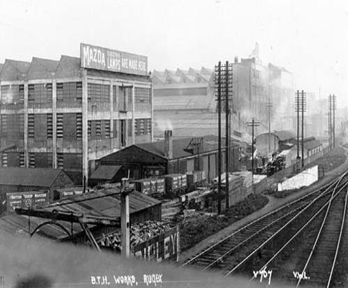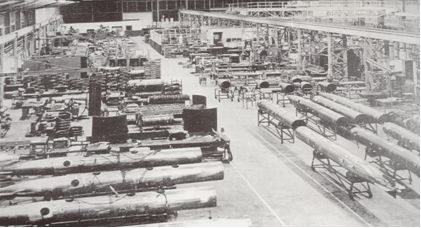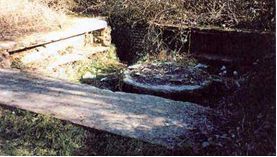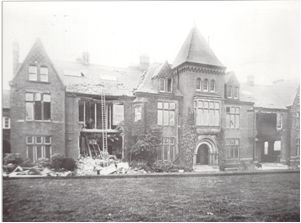Lying half a mile north of Rugby town centre, and occupying a crucial position at the heart of the national rail network, Rugby's railway station was constantly under threat from enemy attack. Furthermore, with several factories adjacent to the station on Mill Road, the need to defend this vulnerable area of Rugby was of the utmost importance.

|
Figure 6: Postcard of Rugby BTH works and railway sidings (photo courtesy of Warwickshire County Records Office)
|
Based here was British Thomson-Houston (BTH), which was involved with Ministry of Defence projects through the research, design and manufacture of various devices.

|
Figure 7: Torpedoes ready for dispatch (photo courtesy of the Rugby Advertiser)
|
These included detection equipment, technical parts, radio valves and transmitters, and electric torpedoes (Wessex Archaeology 2007, Ref. 65700.02). A direct railway track servicing the plant facilitated transportation.
In an attempt to defend both the station and its adjacent factories from aerial attack, a series of manned gun emplacements were strategically positioned to form a defensive ring comprising eight Bofors and eleven Lewis Guns.
- A circular holdfort for Bofors Gun Emplacement (BGE) behind Rokeby School (HER MWA 8857)
- A BGE 100m metres to the North of Lower Hilmorton Road (HER MWA 8860)
- Three Lewis Gun Emplacement (LGE) in the centre of Rugby (HER MWA 8861, 8864, 8863)
- A BGE 500 metres to the south east of Brownsover (HER MWA 8858)
- A BGE on Johnson Avenue, north of Bilton Road (HER MWA 8865)
- A BGE next to the railway, opposite the Rugby cement works (HER MWA 8866)
- A circular holdfort for a Bofors gun located in Newbold Quarry Park (HER MWA 8867)
- A light anti aircraft emplacement (used to protect the Lodge Plug Works). Located 200 metres west of the Clifton Road Cemetary (HER MWA 9670)

|
Figure 8: Bofors gun holdfort, north of Bilton Road (photo courtesy of Armishaw 2000)
|
The Bofors anti-aircraft gun was capable of rapidly firing high-explosive shells. Sited opposite Rugby Cement Works, on top of a spoilheap next to the Rugby to Coventry rail line, this circular concrete holdfort is considered the best preserved of the Rugby sites (HER MWA 8866). Nearby is another , archaeologically-investigated in 2004 (HER MWA 8865) (Phillips 2004).

|
Figure 9: The bomb-damaged Willans Works at Newbold Road in 1941 (photo courtesy of the Rugby Advertiser)
|
However, despite this ring of defences, some sites unfortunately fell victim to enemy bombing.
Engineering firm Willans and Robinson, manufacturers of central valve steam engines, owned two factories in Rugby - at Mill Road and Newbold Road. Despite having a gun emplacement less than 100 yards away from its factory gates, the Newbold Road site was damaged by three bombs dropped by a solitary German aircraft in 1941. Windows were broken and part of the building frontage was destroyed.
The BTH factory at Mill Road escaped attack and until recently, stood as a testament to the success of the wartime defence of Rugby. Its buildings were partially demolished in 2007 as part of redevelopment (Wessex Archaeology 2007, Ref. 65700.02).

